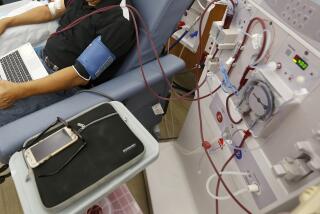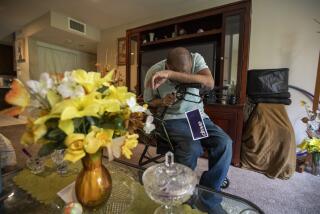A better option for dialysis patients
- Share via
There’s no doubt that dialysis saves the lives of people with advanced kidney disease -- without it, the toxins in their blood would quickly overwhelm their organs and kill them. But it comes with a price.
The lengthy treatments to cleanse the blood must be done three times a week, patients must adhere to strict diets while battling fatigue, and life-threatening medical problems are a constant threat.
For the record:
12:00 a.m. Feb. 5, 2003 For The Record
Los Angeles Times Wednesday February 05, 2003 Home Edition Main News Part A Page 2 National Desk 15 inches; 548 words Type of Material: Correction
Frequent dialysis -- In Monday’s Health section, an article on daily dialysis regimens incorrectly said that dialysis was first developed in the early 1960s. In fact, the first artificial kidney was invented in 1942. It was the creation of a Teflon shunt in the 1960s that made it possible to treat patients long-term.
For The Record
Los Angeles Times Monday February 10, 2003 Home Edition Health Part F Page 8 Features Desk 3 inches; 113 words Type of Material: Correction
Frequent dialysis -- In last Monday’s Health section, a story on daily dialysis regimens incorrectly said that dialysis was first developed in the early 1960s. In fact, the first artificial kidney was invented in 1942. It was the creation of a Teflon shunt in the 1960s that made it possible to treat patients long-term.
It might not have to be this way. Doctors and patients are finding that more frequent dialysis can ameliorate many of the pitfalls experienced with the traditional process to remove toxins from the bloodstream.
About a dozen dialysis centers nationwide, including three in the Los Angeles area, now offer daily, at-home hemodialysis to approximately 300 to 400 people. Some patients cleanse their blood during a two- to three-hour session during the day; others prefer to do it while they’re sleeping. Both use the same equipment found in dialysis centers.
“This is a way of getting patients back to a more normal lifestyle and improving their health,” says Dr. Larry Idroos, chief of nephrology at Kaiser Permanente Los Angeles Medical Center, which has just launched a daily, at-home dialysis program. “In the future, as many as 50% to 60% of dialysis patients would be good candidates for this procedure.”
Currently, about 250,000 of the nation’s end-stage kidney disease patients have to travel to dialysis centers, where they sit at machines for three to five hours three times a week while their blood is removed, cleansed of toxins, and returned to their bodies. The treatment leaves people feeling drained or ill.
“It’s very hard to live a normal life when you’re on dialysis,” says Richard Snyder, 48, of Trabuco Canyon. A former engineer who has diabetes, Snyder is starting a home dialysis program to prevent further deterioration in his health.
Because their kidneys no longer flush out fluids, people with end-stage kidney disease can’t drink more than 1 1/2 quarts of liquid a day. Nor can they eat much food with potassium and phosphorous, which their bodies no longer metabolize properly. This can include red meat, nuts, dairy products, and many fruits and vegetables.
Between dialysis sessions, dangerous toxins accumulate in their blood, triggering a cascade of problems such as heart disease, high blood pressure, severe pain in joints where calcium collects, and impaired cognitive function.
Patients spend an average of two weeks a year in the hospital for complications related to their kidney failure. Mortality rates are staggeringly high -- half of dialysis patients die within six years.
A 2002 study by Canadian scientists, who have pioneered the use of nocturnal dialysis, has shown that most daily dialysis patients don’t need blood pressure drugs, require less of a costly medication for anemia, spend half as much time in the hospital, have fewer treatment-related symptoms, and suffer little of the collateral damage experienced by conventional dialysis patients, such as an enlarged heart, joint calcification or high blood pressure. When all expenses were factored in, the Canadian research found that nocturnal dialysis costs about $7,000 less than conventional treatment, which runs about $70,000 annually. The study involved 75 patients.
Because dialysis is done more often, waste removal is more efficient, eliminating between-treatment “peaks and valleys,” and shrinking calcium deposits. “Patients feel and look so much better,” says Dr. Andreas Pierratos, a kidney specialist at the University of Toronto who helped devise a nightly dialysis regimen in 1994. “They can eat and drink whatever they want, work full-time, and have energy to do things.”
Judy Weintraub of Los Angeles says nocturnal dialysis is “an investment in my future.” Weintraub, whose kidneys failed when she was 15 because of a rare genetic disorder, has been on dialysis for 28 years, and had three unsuccessful transplants, mostly recently in 2000.
The convenience, autonomy and promise of improved health prompted the 43-year-old former special education teacher to switch to nocturnal dialysis in November. First, she had six weeks of training on operating and cleaning the dialysis machine. After she started using the device, she had to learn to sleep tethered to the equipment.
“It was a huge adjustment,” says Weintraub, who spends two hours a day setting up, dismantling and disinfecting the machine. But now that her days are free, she says, “I’m looking forward to returning to work full-time.”
The most common causes of kidney failure are diabetes, high blood pressure and kidney disease. Transplants are an option, but because of the lack of donors, only 13,000 transplants are performed each year in the United States, and more than 2,000 people died in 2001 waiting for a kidney. This makes the need for better dialysis methods more urgent.
Daily dialysis isn’t for everyone -- at least not yet.
The evidence that daily dialysis is better is largely anecdotal. Critics point out that only the healthiest patients can do daily dialysis, which is why their outcomes are better. “In the larger renal community, there remains a great deal of healthy skepticism about this,” says Paul W. Eggers, an epidemiologist at the National Institute of Diabetes and Digestive and Kidney Diseases in Bethesda, Md.
Also, some patients, especially the elderly, might be unable to operate the complicated equipment; others may fear undergoing the procedure without supervision. “It takes a highly motivated individual,” says Dr. Brent W. Miller, a kidney specialist at Washington University in St. Louis. “They also need family support to help operate the machines.”
The recent development of personal dialysis machines may enable more patients to take over their own treatment. The first to hit the market, the Aksys PHD (personal hemodialysis system), was approved by the Food and Drug Administration in March. The computer-operated device takes much less time to set up and dismantle than conventional dialysis machines, and doesn’t require an outside water source.
Two local medical facilities, Kaiser Permanente Los Angeles Medical Center and St. Joseph Hospital in Orange, have purchased these machines, and their first patients, including Snyder, are scheduled to start using them this month.
“This is the first real advancement we’ve seen in decades,” says Mary McKenzie, director of renal services at St. Joseph Hospital.
These new machines go for about $40,000, compared with $16,000 for conventional equipment. “But a couple of days in the hospital cost a lot more than the machine,” says Dr. Scott Rasgon, director of the home dialysis program at Kaiser Permanente Los Angeles Medical Center. If all goes well, Kaiser plans to add six to 10 patients to this program within the next year.
Still, the biggest stumbling block is Medicare, which reimburses clinics for only three treatments a week. Although Kaiser Permanente will pay for the entire program, most insurance companies follow Medicare’s lead. The centers that offer it more often are losing money, say experts. “Profit margins are literally razor-thin -- to throw in an extra treatment is cost prohibitive,” says Dr. George O. Ting, medical director of dialysis services at El Camino Hospital in Mountain View, Calif., which started daily in-center dialysis in 1999 for seriously ill patients who could no longer tolerate the two-day gaps between treatments.
When dialysis was first developed in the early 1960s, some patients did undergo dialysis five and six times a week; a handful of people even had it at night. These programs were abandoned in the early 1970s when Medicare agreed to pay for three weekly sessions, which became the industry standard.
“Three times a week was a compromise,” says Dr. Christopher R. Blagg, executive director emeritus of the Northwest Kidney Centers in Seattle and a dialysis pioneer who helped formulate the Medicare guidelines. “We knew more would be better, but this was a way of treating the most patients reasonably well when funding was very limited.”
In-home daily dialysis will ultimately supplant current regimens, Blagg says, “because everyone who has done it thinks it’s great. The number of dialysis patients is going to double in the next 10 years, and the nursing shortage isn’t going to go away. So why not send a patient home?”






